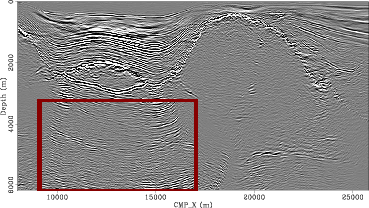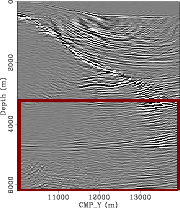|
|
|
|
| Inline | Crossline | ||||
| Min CMP | Max CMP | Aperture (m) | Min CMP | Max CMP | Aperture (m) |
| 5000 | 32000 | 10000 | 10000 | 14000 | 4000 |
In order to efficiently migrate the data with shot profile migration, I removed the time samples before the water-bottom arrival. This is equivalent to time-shifting the data (changing its origin) and I compensated for it by applying a linear frequency shift to the source wavelet. The propagation through the water layer was done in two depth steps and from there down the depth sampling was 10 m. The propagation was done with a Phase Shift Plus Interpolation algorithm (, ,). For the sake of computer time, only two reference velocities, computed with Lloyd's algorithm (, ), were used to propagate the data at each depth step. Four hundred frequencies were used from 6 to 40 Hz. A total of 8600 shots were migrated. Figure 6 shows an inline section taken at CMP-Y=11840 m. Again, recall that the depth axis is with respect to an arbitrary reference. The migrated data was filtered in depth and a gain proportional to the depth squared was applied for display purposes. Both the top and bottom reflections of the smaller salt body are well imaged, as are most subsalt reflections directly below it. The salt bottom reflection for the larger salt body is also well imaged but its right flank is poorly imaged because of lack of data. The available dataset did not extend enough beyond CMP-X=25000 m to capture the corresponding reflections. Notice what seems to be a multiple below 4000 m depth, specially around CMP-X=16000 m. The rectangle encloses the subset image that was deemed most promising to illustrate the attenuation of subsalt multiples. A new shot profile migration, including the computation of prestack images was carried out on this subset of the data.

|
|---|
|
mignooffs-inline
Figure 6. Shot profile migration. Inline image section at crossline CMP 11440 m. The rectangle encloses the subset of the image for which a new migration was performed including the computation of prestack images. |
|
|
Figure 7 shows the crossline image section taken at CMP-X=12000 m. Notice that the bottom of the salt and the subsalt reflections deteriorate to the left of about CMP-Y=11500 m. This again is due to lack of available data to the left of CMP-Y=10000 m. Here again the rectangle encloses the subset of the data to attempt the attenuation of subsalt multiples.
|
mignooffs-xline
Figure 7. Shot profile migration. Crossline image section at inline 12000 m. The rectangle encloses the subset of the image for which a new migration was performed including the computation of prestack images. |

|
|---|---|
|
|
|
|
|
|